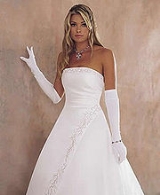
Debutante Dress
Encyclopedia
For more information see Débutante
 A debutante dress is a white evening gown
A debutante dress is a white evening gown
, accompanied by white gloves and pearls worn by young women at their debutante ball. Debutante balls were traditional coming of age
celebrations for eligible young ladies ready to be presented to society as ready for marriage.
.
However a doctor's certificate could be presented at the time stating that low cut was injurious to the young woman's health.
Queen Victoria was said to have hated small feathers, so orders were sent out that Her Majesty wished to see the feathers as the young lady approached. Late in Queen Victoria's reign and into the court of Edward VII, the necessary headdress was three feathers arranged in a Prince of Wales plume. A center feather slightly higher than the two on each side worn slightly on the left side of the head.
For young ladies and women to be presented who were in mourning, it was acceptable for their dresses and veils to be black. No matter how cold the weather was on this special day, absolutely no cloaks, shawls, capes, or wraps of any kind were permitted to be worn. Those items remained in the lady's carriage.
Debutante
A débutante is a young lady from an aristocratic or upper class family who has reached the age of maturity, and as a new adult, is introduced to society at a formal "début" presentation. It should not be confused with a Debs...

Evening gown
An evening gown is a long flowing women's dress usually worn to a formal affair. It ranges from tea and ballerina to full-length. Evening gowns are often made of a luxury fabric such as chiffon, velvet, satin, or silk...
, accompanied by white gloves and pearls worn by young women at their debutante ball. Debutante balls were traditional coming of age
Coming of age
Coming of age is a young person's transition from childhood to adulthood. The age at which this transition takes place varies in society, as does the nature of the transition. It can be a simple legal convention or can be part of a ritual, as practiced by many societies...
celebrations for eligible young ladies ready to be presented to society as ready for marriage.
Required rules of dress
A young lady's gown was regulated by a set of meticulously defined rules which were strictly enforced. These rules varied from monarchy to monarchy and didn't always follow the fashion of the time. White was the preferred color for her gown, although soft colors such as ivory or eggshell were acceptable as long as they were over a white background. The headdress always included feathers and a veil although the number and size of the feathers varied with the time. Married women were required to wear a tiaraTiara
A tiara is a form of crown. There are two possible types of crown that this word can refer to.Traditionally, the word "tiara" refers to a high crown, often with the shape of a cylinder narrowed at its top, made of fabric or leather, and richly ornamented. It was used by the kings and emperors of...
.
Georgian Era
During the reign of King George III and Queen Charlotte, the debutante dress featured a hoop skirt and elaborate trimmings which included a single ostrich plume worn on the head, even though simple dresses with high waists were favored. During the reign of King George IV, the hoop skirt was excluded and the style for a debutante gown became a variation of whatever was considered popular for formal evening wear during the period.Victorian Era
For a young woman of this time, It was not an un-common practice for women to have their debutante gown modified into a wedding dress. These gowns were often made with two different bodices, one being for the presentation and the other one for her wedding. The dresses of this time were almost always short-sleeved and had to have a low neckline.However a doctor's certificate could be presented at the time stating that low cut was injurious to the young woman's health.
Queen Victoria was said to have hated small feathers, so orders were sent out that Her Majesty wished to see the feathers as the young lady approached. Late in Queen Victoria's reign and into the court of Edward VII, the necessary headdress was three feathers arranged in a Prince of Wales plume. A center feather slightly higher than the two on each side worn slightly on the left side of the head.
For young ladies and women to be presented who were in mourning, it was acceptable for their dresses and veils to be black. No matter how cold the weather was on this special day, absolutely no cloaks, shawls, capes, or wraps of any kind were permitted to be worn. Those items remained in the lady's carriage.

